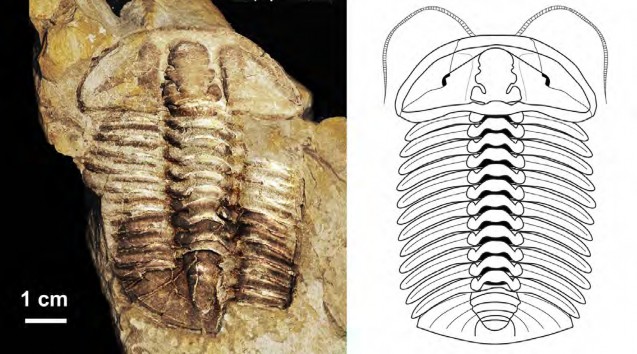
Author: Dr Patrick M. Smith, Technical Officer, Australian Museum
Extract from National Rock Garden Newsletter No. 20, November 2020
A new species of trilobite (a type of extinct marine animal) has been discovered in shales belonging to the Gordon Group in northern Tasmania. These rocks were deposited approximately 450 million years ago during the Late Ordovician Period, when Australia was part of the great landmass Gondwana. This was a time when complex marine ecosystems were just starting to develop, and when the first primitive plants were appearing on land.
Australian scientists, Dr. Patrick M. Smith, Australian Museum (AM) and Dr. Malte C. Ebach, University of NSW (UNSW), have called the newly discovered trilobite after the actor Tom Baker, aka Doctor Who, by means of the rather impressive name of Gravicalymene bakeri. The first part of the name identifies the genus to which the species belongs, while the second part, the specific name, uniquely identifies the species within the genus. Palaeontologists call this “Binomial Nomenclature” or more simply the “two- term naming system”.
The discovery is reported online (pre-press) in the most recent volume of Alcheringa, the Australasian Journal of Palaeontology (Smith and Ebach, 2020).

Naming the new fossil after Tom Baker, Dr Smith explained that he had been inspired to follow a career in science thanks to Baker’s particular incarnation of ‘Doctor Who’. Patrick commented that he was not old enough to remember Tom Baker’s episodes which were originally aired between 1974 and 1981. However, while growing up as a teenager in the early 2000’s, he followed the show keenly and became convinced that a career in science was guaranteed to improve the world.
‘In particular, it inspired me to study the concept of ‘Time’—as the Doctor travels through time. Hence, the area of science I specialise in is biostratigraphy, which is all about dating the age of Earth and its rocks’ said Dr Smith.
Patrick’s co-author, Dr. Malte Ebach, who first found the trilobites, said that palaeontologists often discover fossils in unusual circumstances. He explained the method of discovery as follows: “In the late 1990s I was caught short while driving through Gunns Plains in Tasmania. Relieving myself on a convenient boulder I noticed that it was covered in trilobites. Palaeontologists discover fossils in the most surprising ways”. And of course, Dr Ebach is also a Doctor Who fan. He was inspired to explore that natural world by Doctor Who, and especially the actor Tom Baker.
Tom Baker, who is based in the U.K., has said that he was thrilled to hear the news that an ancient and incredibly rare specimen had been named in his honour.
Arguably the second most famous fossil group after dinosaurs, trilobites are known by their distinctive three-lobed body. Their closest living relatives are segmented creatures such as crustaceans (e.g. prawns and crabs), chelicerates (e.g. spiders, scorpions, and mites), insects, millipedes, and centipedes.
While trilobites were common in Australia during the Ordovician, this new species is part of a genus that has previously only been found in Europe and North America at this time. Appearance of the genus in Tasmania may suggest that Australia was somehow connected to these other continents by oceanic currents.
The specific characteristics of which make this new fossil of particular interest are combination of a relatively straight anterior margin on the head; a semi-cylindrical glabella (nose-like element) which gently tapers forward; little to no deflection in the axial furrows adjacent to the largest glabella lobe; 12 thoracic segments; six axial segments on the pygidium; and four faint to almost effaced pleural ribs on the pygidium.
For help with some the technical terms used in the previous paragraph, please visit the Australian Museum webpage.
References
Patrick M. Smith & Malte C. Ebach, 2020. A new Ordovician (Katian) calymenid, Gravicalymene bakeri sp. nov., from the Gordon Group, Tasmania, Australia, Alcheringa: An Australasian Journal of Palaeontology, DOI: 10.1080/03115518.2020.1797874
Richard A. Fortey, 2001. Trilobite!: Eyewitness to Evolution. HarperCollins, New York, USA. 269 pp. https://www.scientificamerican.com/article/a-429-million-year-old-trilobite-had-eyes-like-those-of-modern-bees/


